So here we are, marching through the year, motor racing back on the radio, summer cannot be too far away, though you would never know it if you looked out of the window at the moment, for it is raining horrendously.
Another hectic week, most of which was spent trying to get my canine companion to eat. He is showing his age now, and finicky about his food, he picks up the mince, almost immediately spits it out beside the dish, and walks away. However I am glad to say that after two days of refusals, of chicken and of mince, however small I cut it, today I managed to find something that he would eat, thanks to my walking up to Waitrose in the rain (or at least walking in the rain to the bus stop and walking back to the shop once I got off the bus.)
Thanks also to Lily`s Kitchen, who supplied what he ate.
And maybe after a few days I can again introduce the mince, just to see what happens.....
So this week there has been a little progress on the Card Index and Gallery, and I have also, tonight, changed the double card, but not yet changed the description, of what was formerly John Player`s Egyptian Kings & Queens and Classical Deities (March 1912). It is now Cadet Sweets "The Conquest of Space" and you can see it at https://csgb.co.uk/cardoftheday/2023-03-01
Other new cards are :
Anonymous / Godfrey Phillips [tobacco : O/S : ] “Famous Footballers” (1936) - https://csgb.co.uk/cardoftheday/2022-02-26
Clevedon [trade : confectionery : UK] "Famous Footballers" (1961) - https://csgb.co.uk/cardoftheday/2022-03-05
Imperial Tobacco Co. of Canada [tobacco : O/S : Canada] “Fishes of the World” (1904) - https://csgb.co.uk/cardoftheday/2022-03-06
Trucards [trade/commercial : cards : UK] "World War One" (1972) - https://csgb.co.uk/cardoftheday/2023-06-28
W.D. & H.O. Wills [tobacco : UK] "First Aid" - with clause (April 1913) - https://csgb.co.uk/cardoftheday/2022-03-01
And so, to this week`s newsletter - which includes vintage vending, a beautiful blonde, an Eastern Electric, Britannia Bridge, the Fosbury Flop, a Pulchritudinous Pearson and a Super Speedway......
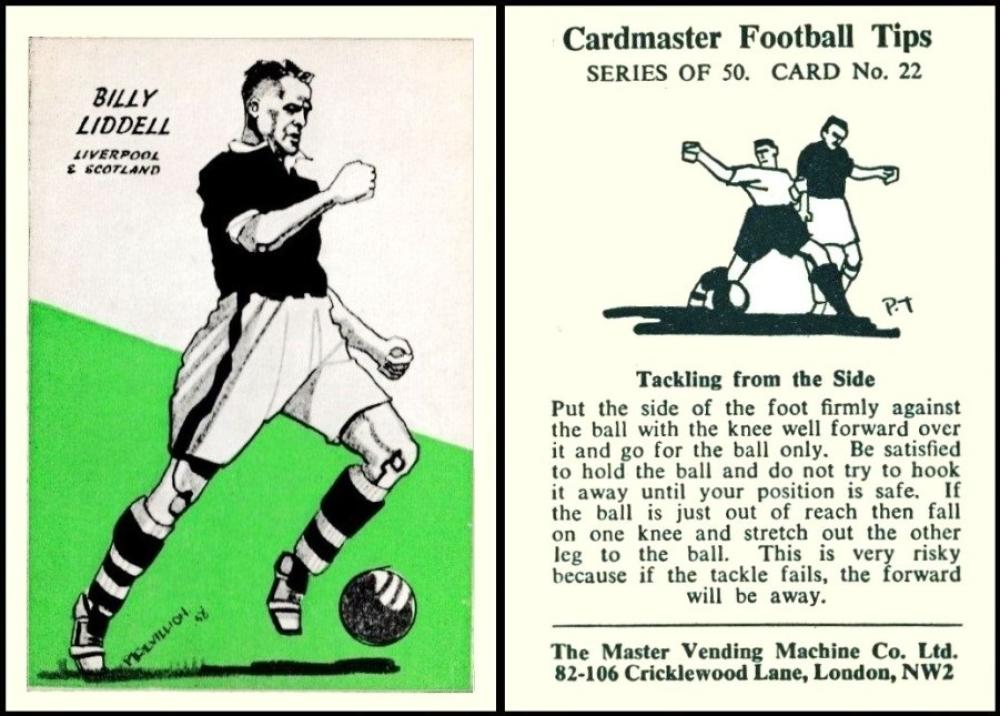
The Master Vending Co. Ltd [trade/commercial : vending machines : UK] "Cardmaster Football Tips" (1958) 22/50 - MAS-150 : MCA-2
A last minute substitution with this one, for I failed to track down a card of my intended subject. However this is an intriguing one, because I hit on the fact that the first vending machine was installed on March 2, 1888, to dispense chewing gum.
Some references will tell you that the gum was Adams Gum, and others that it was made by the American Chicle Company. In fact this is the same company, and person, Thomas Adams, Jr., who started the company with two friends, Messrs Beeman and Primle.
It is also recorded that he invented chewing gum (which is not entirely correct, but he did introduce it to North America after seeing the so called chicle being chewed in Mexico.) In fact his intention was to use it as rubber to make cheaper tyres, but it proved unsuitable for that so he marketed it for chewing.
Finally, it is said that he invented the vending machine. Some cast doubt on that, and rightly, because in very ancient times there were machines that dispensed necessities on receipt of a coin or token, but he did have the patent on a chewing gum making machine, so it may well be true. We know that he did install that machine, in New York, capitalising by calling it "New York Gum". And it was a great success. We also know that in 1907 he was the first person to install a variant machine, which dispensed gumballs.
This is kind of the British equivalent to that success story, The Master Vending Machine Company, who were based in Southend, but had a London address in Wardour Street. Their coin-operated machines were more of the gaming type, and were very popular, especially the ones with footballing themes. They started out as just games in arcades, and then produced an add-on machine which also dispensed cards.
This set first appears in our British Trade Index part II as
CARDMASTER FOOTBALL TIPS. Lg. Nd. (50). Where text is long, e.g. card No.7, firm`s name is eliminated.
There is a bit more about the set in part III, namely :
MCA-2 (Cardmaster Football Tips) . Each football tip on back is found with two different action pictures of a footballer on the front. The fifty footballers with card numbers on backs in parentheses are listed below.
This is true, but it is too light to scan. Anyway, in our updated volume it says :
CARDMASTER FOOTBALL TIPS. 1958-59. Nd. (50). Each card is found with two different action pictures of a footballer on front. The two sets are listed at HM-28.
So maybe HM-28 will scan better!
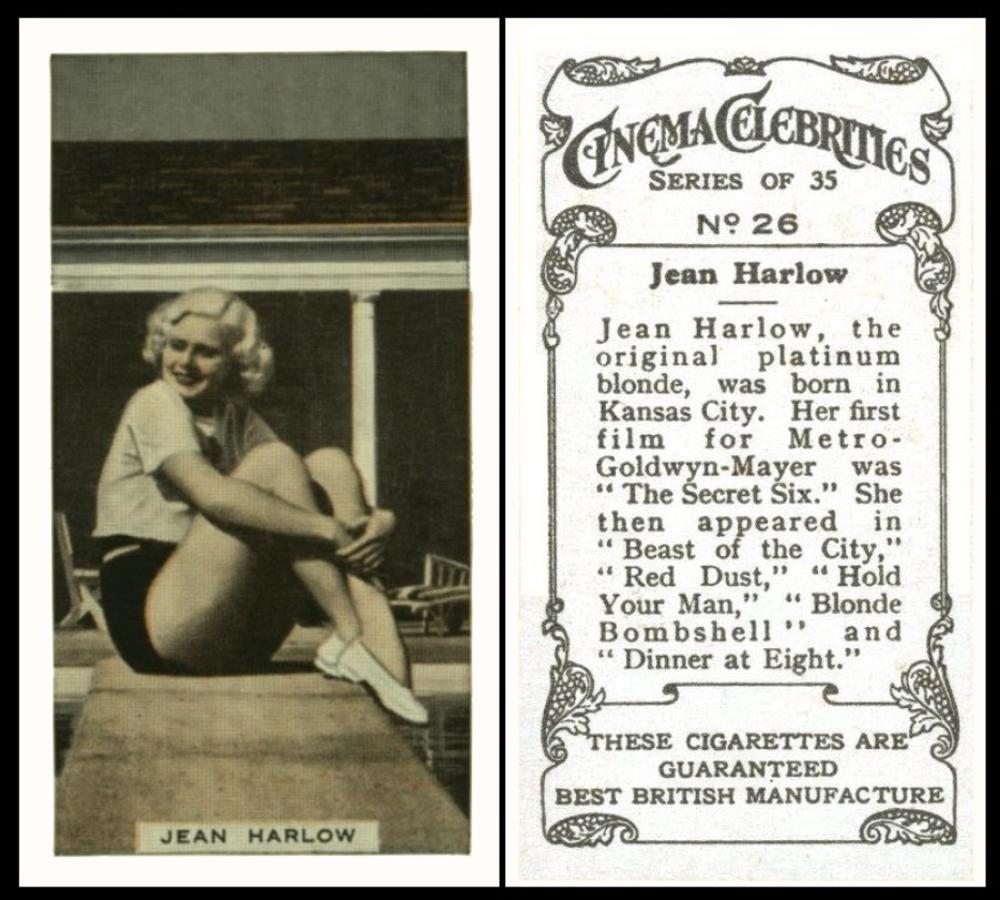
Anonymous [tobacco : O/S : ?] "Cinema Celebrities" (1933) 26/35 - ZA05-180 : ZA5-1
Today in 1911 saw the birth of our featured star. She was christened Harlean Harlow Carpenter. but you may know her better as either her stage name, Jean Harlow, or her nicknames, The Platinum Blonde, and the Blonde Bombshell (which, as our card reveals, was the name of one of her films).
In 1923 her mother took her to Hollywood. She was almost twelve, but was repeatedly told that she was too old. They stayed on, hoping, and she attended school in Hollywood, but she left two years later and they moved back to Kansas.
By the end of 1927 she was married, and so was her mother. Her mother married first and it seems likely that she was unwanted so she found an alternative. He had money, enough that neither of them needed to work, and also enough to move to Los Angeles, where they seem to have lived at an endless whirl of parties. She flirted with the movies, getting casual roles as "extras". This seems not have been to the liking of her husband and they were separated in 1929, divorcing later the same year.
In 1930 she met Howard Hughes, some say at a party. He was making a war movie, with lots of flying, called "Hell`s Angels" - and he had been making it for some time, long enough that it started out as a silent film and was now being adapted with sound. Problem was his current leading lady, the Norwegian Greta Nissen, had a rather unsuitable accent. The part made her name in Hollywood, but then Mr. Hughes lost interest and did not give her any decent parts to follow the success with.
She luckily ended up contracted to Metro Goldwyn Mayer. This is cited as happening in in 1932, but her first film for them is listed on this card, "The Secret Six", released in 1931. M.G.M. did know what to do with her, and made her a sparky femme fatale, also allowing her to showcase her flair for comedy.
She had met her future second husband on the set of "Hell`s Angels" too, the director Paul Bern. They were married in 1932, but two months later he was dead. It still remains a question as to whether it was suicide or murder. She consoled herself with a not-so-secret affair with the boxer, Max Baer. When the studio found out they made her break up and pretty much forced her to get married to cinematographer Harold Rosson, but they were divorced eight months later.
In 1937, she was cast opposite Clark Gable (who had also been in "The Secret Six"), in a film called "Saratoga". However she was suffering badly with her health, and it grew steadily worse. She collapsed on set, and was admitted to hospital, where she died, aged just twenty-six.
This card may be anonymous, and in both our World Tobacco Issues Indexes it appears in the back, but it is listed under section 1C.a as :
"Home Issues inscribed "These Cigarettes are Guaranteed Best British Manufacture". Issued by Hill
The listing for the set is :
CINEMA CELEBRITIES. Sm. 66 x 36. Nd. (35) See Ha.572-A
Which we may not have time to look at tonight! But you never know.
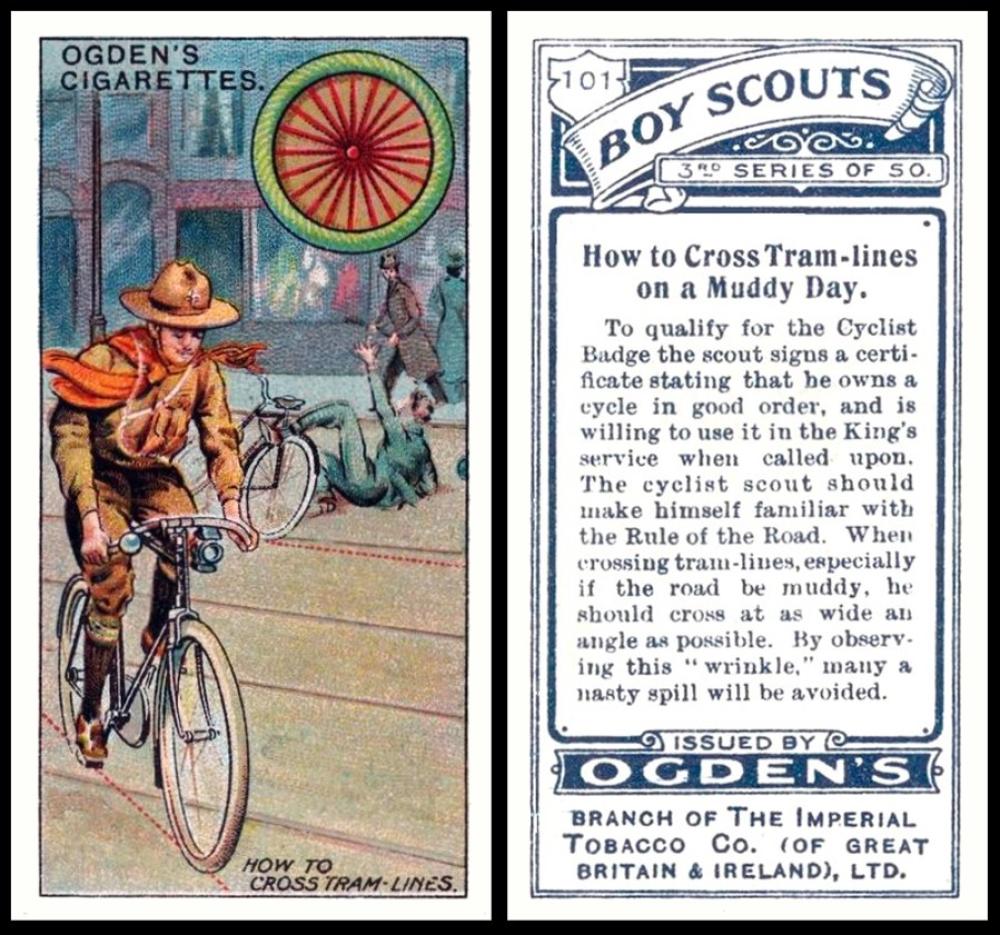
Ogdens Ltd. [tobacco : UK] "Boy Scouts" third series (1912) card 101 - O100-412.3.A : O/2-94.3.A : H.62 : O/43.a
Today in 1882 the first electric trams were used in Leytonstone, East London. There had been trams on that route before, but they were pulled by horses.
Horse trams had started a while earlier, in March 1861, with the first route being a round trip between Marble Arch and Notting Hill Gate.
However this was only the first horse tram in London, for in Wales horse drawn trams had been running since 1807. In 1877 those horses were replaced by steam - and stayed steam driven until 1929.
Now by the time this card was issued, in 1912, fifty years on, the crossing of tramlines without getting stuck ought to have becone second nature. So why the poor chap behind has come to grief, who knows?
Mind you this could well be a bicycle card that collectors of such things have not yet come across....
Our original Ogdens reference book lists this group of Boy Scouts cards together, the first number, 225, referring to the number of cards in the entire lot. Our set is O/43, which reads :
225 BOY SCOUTS, (1911-14) Fronts lithographed in colour. Backs with descriptive text. Home issues.
43. 3rd Series of 50. Numbered 101-150. Backs in (a) blue (b) green. Issued 1912. Similar series issued by Churchman (1st series)
The World Tobacco Issues Indexes also group it, but reduced, to :
BOY SCOUTS. Sm. Nd. See H.62
3. "3rd Series of 50". Nd. 101/150. Back in (A) blue (B) green.
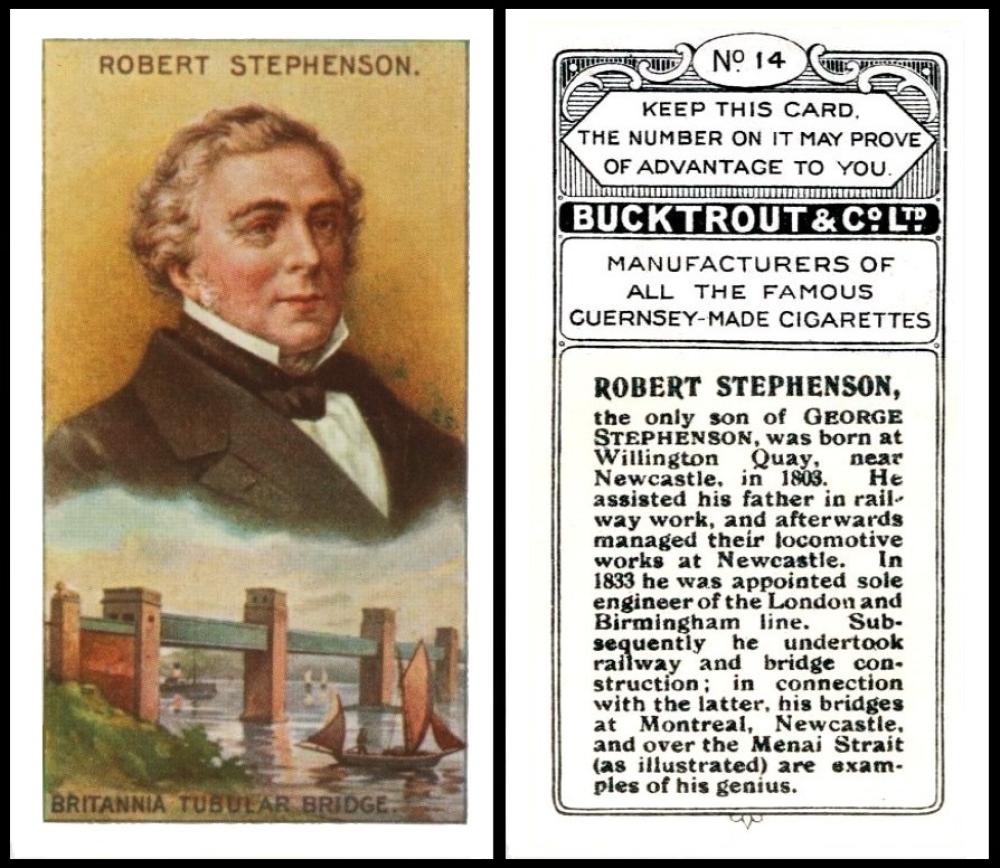
Bucktrout [tobacco : UK / Channel Islands] "Inventors Series" (1924) 14/20 - B866-300 : B150-5 : H.213
Today in 1850 this bridge, the Britannia Bridge, or more correctly, the Britannia Tubular Bridge, was completed.
The decision to build it was forced, but not entirely by the popularity of rail travel with the general public, more by the fact that Members of Parliament who needed to travel to and from Ireland, via Angelesey, wanted it.
At first it was thought that this could be sorted out by simply adding a railway line to the road that already formed the current Menai Suspension Bridge, but that proved impossible. So this second bridge was the only option.
This set appears in our World Tobacco Issues Indexes as :
INVENTORS SERIES (A) Sm. 68 x 38. Nd. (20). See H.213. Found with and without high numerals overprinted in connection with a prize scheme.
However this card seems to have the details of the competition but not the numeral. So can anyone show us a scan of a card with the overprint on it?
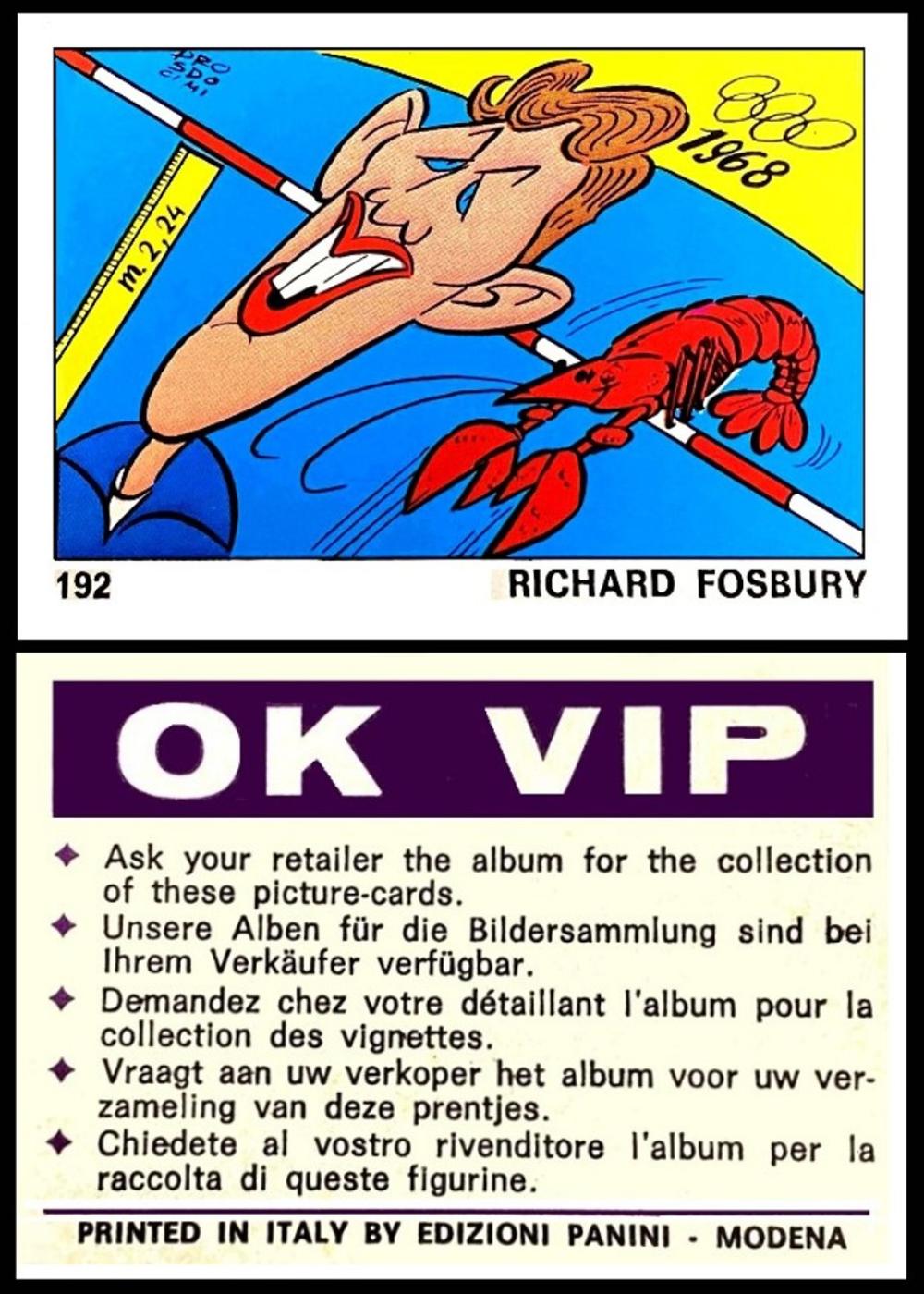
Panini [trade/commercial : O/S : Italy] "OK VIP" (1973) 192/200
So here we have Richard Douglas "Dick" Fosbury, who in 1947 changed the world of the high jump forever. He was born today, in Portland, Oregon, and was sports mad. However he had difficulty perfecting the high jump, something he yearned to do. Instead of giving up, he worked on other ways that may not have been the regulation style, but would help him at least start to clear the bar. He was aided in this by the fact that the rule book only stressed that the take off had to be from one foot alone, there was nothing about the leap or the cross.
What he found would come to be known as The Fosbury Flop, named after him. This involved him leaping backwards, head-first, and kicking up at the end of the jump to carry him across the bar. It was not always a gentle landing, but it worked, and it was slowly refined.
And at the 1968 Olympics in Mexico City, he won the gold medal, with a new Olymoic record of seven feet, four and a quarter inches.
This is a fascinating set and contains many people who do not appear anywhere else, film stars, sporting personalities, rebels and statesmen. Yet it is very little known of.
There is a checklist, at TCDB/OKVIP which will quickly demonstrate the range.
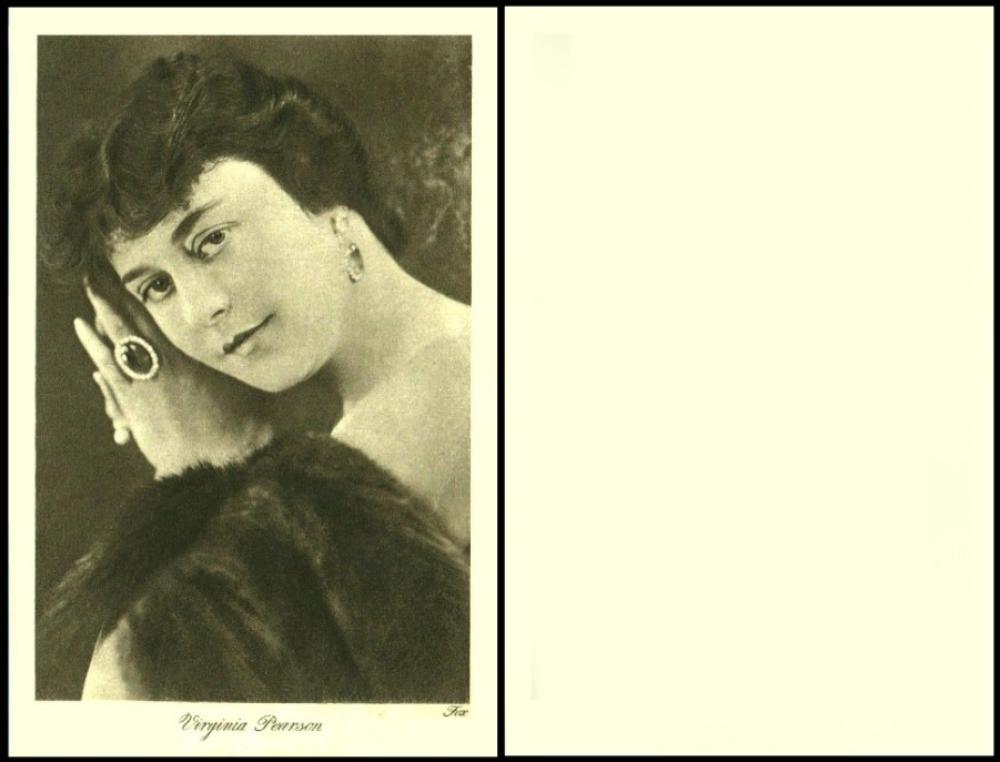
Cinema Chat [trade : magazines : UK] "Film Stars" untitled (1919-20) Un/9 - CIN-050.2.a
Another birthday girl, and here we have Virginia Belle Pearson, born today in 1886 in Kentucky. You may not have heard of her, but she made fifty-one films, and her career ran from 1910 to 1932.
Her first film, "On Her Doorsteps" was kind of an anti-smoking one, where she quarrelled with her boyfriend over her desire to smoke just like him. Of course this was very racy then. He agrees but then gets mad and snatches it from her mouth. She throws him out of the house, but then he proves his love by refusing to move until she takes him back - which, in the end, she does, but not until half the town has become involved.
Movies were simple then.
Less than a year later, she was married, to director Sheldon Lewis, and in semi-retirement. However in 1914 she went back to the movies and made thirty pictures in the next six years. However in 1924 her and her husband ran out of money.
They divorced in 1928, but not because they fell out of love, it was a bit of a gimmick, because at that time filmgoers seemed to prefer that their favourite star was unmarried.
Strangely, and rather wonderfully, the former couple stayed together until his death on May 7th, 1958, and he was still listed as her husband. So did they make the divorce up? Or did they secretly remarry? And, sadly, she died shortly after, almost a month to the day - on June 6, 1958.
Now these cards were given away with a British Film magazine called Cinema Chat, which was actually more of a newspaper than a glossy magazine. There are several sets of them, and they were listed very slowly throughout our original British Trade Indexes parts I, II, and III. Luckily, you can tell the difference between them quite easily, for most have different inscriptions above the picture. Ours does not have that, so it is the last group to appear, in part III. And it is too dark to see that
In our updated British Trade Index it is also the last group to appear, as:
CINEMA STARS (A) 141 x 89. Brown Gravures. Unnd.
1. Front with brown framelines (34 known). Plain back. See HC-89. Anonymous
2. Front without brown framelines (9 known) with (a) plain back (b) postcard back. See HC-90. Anonymous.
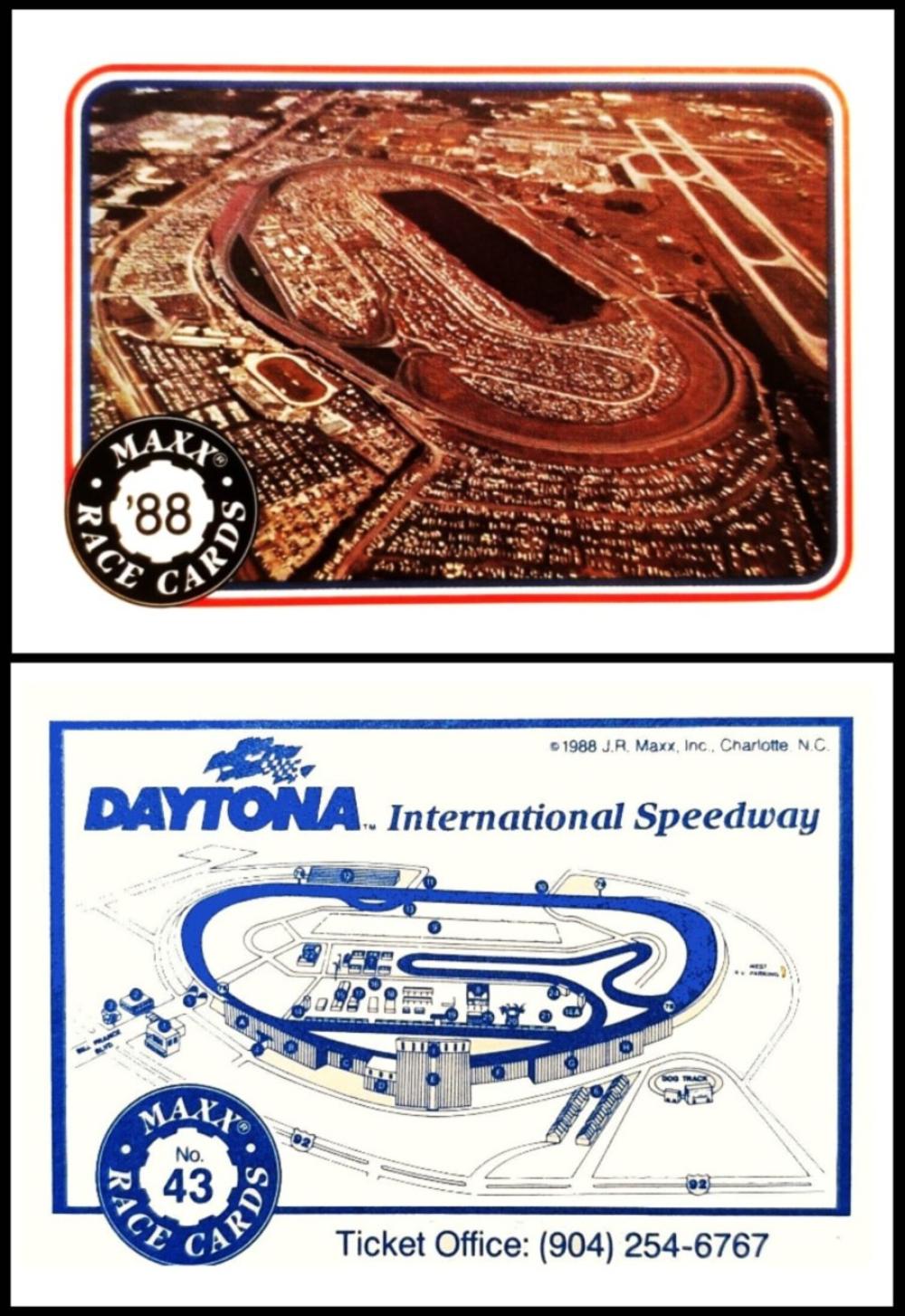
Maxx Race Cards [trade/commercial : O/S : USA] "Race Cards" (1988) 43/100
Now this modern-ish card shows the modern-ish Daytona International Speedway, but the first race at Daytona was today in 1936.
The course at that time was along two of the proper roads and out onto the beach. It was enormously popular with the general public but lost money. As did the second event in 1937.
However in 1938, a man called William France Sr., who had set up a car repair shop in Daytona after moving south from Washington, offered to take over. For some reason this event did make money, and it continued growing until 1942, when it was halted by the American entry into the Second World War.
It only resumed in 1946.
The current track was built in 1959 by the same William France Sr., and it is a banked oval, allowing for better views and higher speeds.
However before that the Daytona area had been the location of many World Land Speed records, starting with Major Henry Segrave in 1927
I am not sure how this set was originally issued, but after it had been out a while it was advertised as being sold complete in a box. I have a feeling that they were out first in packets though - and if anyone knows do tell us please.
This week's Cards of the Day...
have been celebrating the life of the actress Ellen Terry, and we have been regaling you with some very early cards indeed.
Saturday, 24th February 2024

Our first clue card referred to the fact that Alice Ellen Terry was born on the 27th of February 1847 in Coventry, Warwickshire. Her family were travelling players, in a theatrical company based out of Portsmouth, where her maternal grandfather was a minister. The first thing we must say is that she is no relation to the American film actress who called herself Alice Terry, but whose real name was Alice Frances Taaffe (July 24, 1899 – December 22, 1987).
Our Alice Terry, naturally, first appeared on stage as a child, and grew up amidst the sawdust, moving into roles as she aged. Because she was often the age of the person she was portraying there was a naturalness to her performances that an older person could seldom have accomplished. When she was sixteen she married, the artist, George Frederic Watts, born in 1817, who you can see on an Ogden`s Guinea Gold portrait, courtesy of the National Portrait Gallery. We featured one of his paintings as our Card of the Day for the 25th of February 2024. They separated in under a year and she returned to the stage. However she then met an architect, Edward William Godwin, born in 1833, and though they never married they did have two children, and even after they separated officially they remained friends forever.
The player on today`s card is Ronald Raymond Rees, who was born in April 1944, and who played for Coventry City for six years, starting out with their youth team, and moving to the main squad in 1962 when he was almost eighteen. He also played for the National Team of Wales almost forty times. This card almost marks the beginning of the end for our man, because he left Coventry City in 1968, transferred to West Bromwich Albion, but he did not like it here and moved on to Nottingham Forest in 1969. That transfer fee was slightly less, and it continued to drop as he moved to Swansea and then to Haverfordwest. And he died in October 2023, at the age of 79.
Our original British Trade Index part II tells us that this set is from the "Footballers Grouping" which appears in full with the Card of the Day for October 19 2024, simply because that was the first football set ever to be issued by A & B.C. Gum, in 1958-1959. All the other sets are tackled like today`s, in as much as they simply repeat their section of the listing, and not how it interacts with the other sets.
However, today`s set is one of the hardest track down in our British Trade Indexes, for two reasons - firstly that the words "Star Players" are only used to form the cup in the black square on the front of the card - and secondly, even if you do fathom that, this set is catalogued as No.5, catalogued as :
FOOTBALLER GROUPING (A). Md. or Lg. 8 backs illustrated at Fig. ABF-10. Nd. ... ABF-10
5. Titled "Star Players" on front. Back 5 in black. 82 x 56. (55). For anonymous "Pin Ups" issued with this series, see set ZJ9-4
That "ZJ9-4" number is at the back of the book, catalogued as :
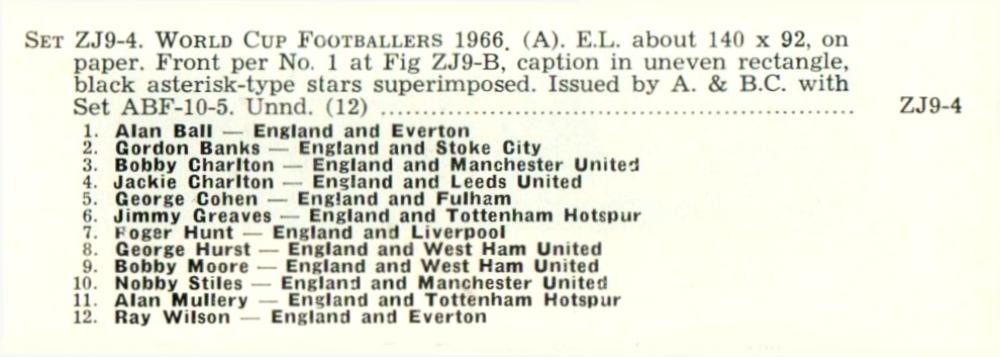
These so called "pin-ups" are also shown on the cards themselves on the bottom of the reverse, as well as being mentioned on the packets, which cost 3d. Now I am not sure how the two were issued together, being that they are different sizes, but being A. & B.C, I kind of imagine that the larger items were simply folded to fit.
In our updated British Trade Index the set is cross-referenced under "Star Players - See under Footballers 1978/68 AAB-350". Once there, both parts are described as :
FOOTBALLERS (A) 1967/68.
1. 81 x 56. Nd. (55). Titled "Star Players" on front. Black backs inscribed "Collect the set of 5 1/2" x 3 1/2" full colour Pin-Ups of England`s Stars".
2. 140 x 92. Unnd. (12). Issued with "Footballers Star Players" see above/ Known as "World Cup Footballers 1966". Anonymous. See HA-13
Sunday, 25th February 2024
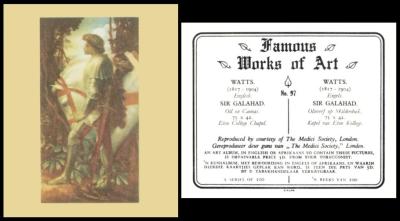
Our second clue shows a very Pre-Raphaelite styled painting, from a very famous artist, George Frederic Watts, born in 1817, who you can see on an Ogden`s Guinea Gold portrait, courtesy of the National Portrait Gallery.
His connection with Ellen Terry came whilst she was appearing at London`s Haymarket Theatre, and she got the chance to have her portrait painted by a leading artist. This portrait, with her surrounded by flowers, was called "Choosing", which is now in the National Portrait Gallery. She looks very young, and she was. Despite that, he asked her to marry him, and, being young, easily swayed, and attracted by his fame, she said yes. She later said she thought it would please her parents to be settled so soon.
They married on 20 February 1864. She was almost seventeen, and he was forty-six. The marriage lasted less than a year, though they remained legally married until 1877. However in the mean time she was getting ever friendlier with an architect, called Edward William Godwin, born in 1833. They had met in 1868, and moved in together, during which time she gave up the stage. She even had two children by him, one in 1869 and one in 1872, but because George Frederic Watts refused to give her a divorce, their children could not legally be given their father`s surname, and so they were both christened with the surname of Craig. To all intents and purposes Mr. Godwin was the love of her life, and even after they separated officially in 1875 they remained friends forever, and he often designed costumes for her.
Her divorce was finally granted in 1877.
Now because we know this set is South African, our first stop must be RB.21, which is our British American Tobacco Reference Book. That lists our set as :
377. FAMOUS WORKS OF ART. Large cards, size 77 x 63 m/m. Front in colour, yellowish borders. Back in grey. in English and Afrikaans, with brief details of picture, and announcement that special album can be obtained; printers credit "C.T. Ltd." at base. Numbered series of 100, Anonymous issue, with letterpress on back.
However because this set is anonymous it is relegated to the back of the World Tobacco Issues Index, under "Anonymous Issues (1) With Letterpress on back - English Language Issues - without references to tobacco - Issues 1919-40 - Bi-Lingual issues." The description there is :
FAMOUS WORKS OF ART. Lg. 77 x 63. Nd. (100). See RB.21/377. Special album issued inscribed with U.T.C., Westminster and Policansky Bros. names
By the time that the updated version of the World Tobacco Issues Index was published, there have been discoveries, and the listing now reads :
FAMOUS WORKS OF ART. Lg. 77 x 63. Nd. (100). See RB.21/377. Special album issued inscribed with U.T.C., Westminster and Policansky Bros. names. Multi-backed.
A. Back "A Series of 100 now being packed with these cigarettes" (25)
B. Back "A Series of 100" with blank space above "C.T. Ltd." (75)
C. Back "A Series of 100" with small vertical line above "C.T. Ltd." (75)
This inscriptiion does indeed appear in the album, but neither Westminster nor Policansky are cited in the World Tobacco Issues Index as having produced this set.
We do know that Policansky Bros., or L. & B. Policansky were based in Cape Town, and that they were associated with Westminster Tobacco.
What follows is a curious and salutory tale because the brothers were doing very well making cigarettes and then they sold their entire company to United Tobacco Co. One of the conditions of this sale was that the brothers would no longer make cigarettes or tobacco. And this they abided to. However at some time in the future two of their sons tried to start the business up again. This was brought to the attention of United Tobacco, and they sued for breaking the agreement. The case was tried in court - and United Tobacco lost...
Policansky also issued cards, between 1925 and 1935, and these were :
-
"Beautiful Illustrations of South African Fauna", which can be found branded for `Mast` or `Mignon`cigarettes
-
"Smarties", a curious set of transfers which RB.21 cites as mentioning The Mayercord Company of America. Now this is slightly wrong, it was the Meyercord Company, of Chicago, and they ran a huge business making decals, transfers, and stick on signs.
Monday, 26th February 2024
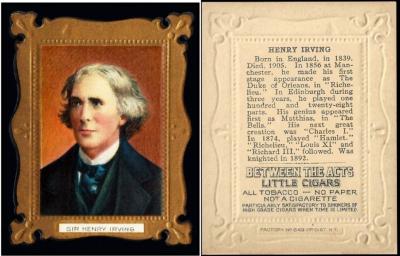
So here for our third clue of the week we have another very important man in Ellen Terry`s life, John Henry Brodribb, better known as Henry Irving.
In 1878, aged thirty, she had joined his theatrical company as their leading lady. The company was primarily based at the Lyceum Theatre, but it also toured - even to America.
This card was issued in 1911, some years after she had taken her American debut in 1883, in a non-Shakespearean play, for she was Queen Henrietta in the play "Charles I". Mr. Irving played Charles I. However she did also get to play Shakespeare on the tour, including two of what would be her most famous portrayals, Portia in the Merchant of Venice, and Ophelia in Hamlet, which she had a fondness for, as it had been the first role she had done with Mr. Irving in 1878.
There is little evidence today that the two were ever more than friends, though she did reportedly say that they were after he died and could no longer confirm or deny. Maybe she hoped they were. She was definitely close to him though, and both separated from their significant others just a few years after they met.
This card does not say American Tobacco, but it cites "Between The Acts" Little Cigars, which is a most appropriate brand for this theatrical set. You can fin it with several addresses at the base, F.493 Md, F.593 Md, (both Maryland) and F.649 NY (which is New York).
Although not named we call the set "Actors", and it is described in our original World Tobacco Issues Index as :
ACTORS (A). Lg. 77 x 61. Gold embossed framework, black border. Unnd. (50). "Between The Acts" brand issue. See ABC/T.25. Ref USA/T.25
The updated version says the same at first but closes not with the American Book of Checklists. Instead it says "F.493, 549, 593 and 649. Ref USA/T.25"
Tuesday, 27th February 2024
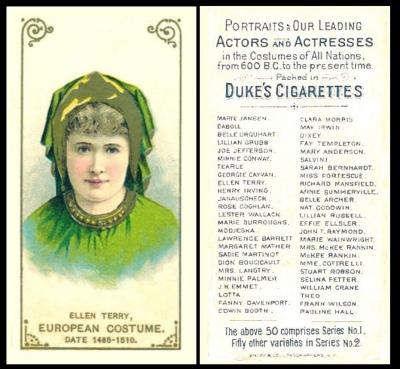
The first thing that is evident is that this set was originally titled as "Portraits of Our Leading Actors and Actresses in the Costumes of All Nations, from 600 B.C. to the Present Time". However this is a bit long for cataloguing so it was reduced to the title we give above - though in the card index both titles will appear, simply because most non collectors would almost certainly hunt for this using the first word "Portraits".
It is described in our original World Tobacco Issues Index as :
ACTORS AND ACTRESSES IN THE COSTUME OF ALL NATIONS. Bkld.
A. Small and medium. For error cards see American Catalog page 137.
1. Series No.1. Ref USA/70. Backlist commences "Marie Jansen"
(a) Small, inscribed "Series No.1" (50)
(b) Medium, inscribed "Duke`s Mixture" (50)2. Series No.2. Ref. USA/71. backlist commences "Ada Rehan"
(a) Small, inscribed "Series No.2" (50)
(b) Medium, inscribed "Duke`s Mixture"B. Large. 3 subjects per card/ Ref USA/94 (30)
We know that our trio in the large size was Ellen Terry, Henry Irving, and Janauscheck. All three are depicted in European Costume from 1485-1510. If anyone has this card and would like to scan it for us we will happily feature it!
The description is slightly altered in our updated version of this book, and there is no mention of the listing of error cards which were in the American Catalog page 137. The rest reads :
ACTORS AND ACTRESSES IN THE COSTUME OF ALL NATIONS. Bkld.
A. Small and medium.
1. Series No.1. Ref USA/70. Backlist commences "Marie Jansen"
(a) Small, inscribed "Series No.1" (50) (b) Medium, inscribed "Duke`s Mixture" (50)2. Series No.2. Ref. USA/71. backlist commences "Ada Rehan"
(a) Small, inscribed "Series No.2" (50) (b) Medium, inscribed "Duke`s Mixture"B. Large. 3 subjects per card, backlist does not show combination. Ref USA/94 (30)
Wednesday, 28th February 2024

Faust was staged at the Lyceum Theatre between December 1885 and 1888, whilst Henry Irving was Actor-Manager. The cast list reveals that Ellen Terry was Margaret (or Marguerite, as shown here), Henry Irving was Mephistopheles, and George Alexander was Faust.
In fact Henry Irving`s Mephistopheles can be seen on two cards issued by John Player, namely “Actors and Actresses” (1898 - card unnumbered) - though as this is a newsletter link you will have to scroll down to Thursday 19th of May - and "Players Past and Present" (1916 - card 1). He actually appears twice in the earlier set, also showing as Ichamo. This is an error, because the name was Iachimo, and he was a character from the Shakespeare play `Cymbeline`
The original written story of Faust was written by Goethe in two parts and the first was published in 1808. The second part was published posthumously in 1832. The opera version was written by Charles Gounod, and made its debut in France in 1859. The story here was an adaptation by William Gorman Wills, and because it was an English version, Ellen Terry was named to be playing Margeret. However this card uses the French version, which could mean whomsoever produced it was going on their knowledge of the book and former play, without keeping up to date with theatreland.
It is recorded in her autobiography that she did learn to spin especially for the part so that she would not look out of place should any handworkers be in the audience. It was also a proper wheel, not a stage prop.
This set appears in our original Taddy reference book (RB.12), published in 1948, in a very curious way, casting doubt as to our title. Maybe "Famous Theatrical Personalities" would have sufficed better? Anyway, the listing reads :
14. 25. FAMOUS ACTORS (11) FAMOUS ACTRESSES (14) (titled). Size 2 5/8" x 1 11/32" or 68 x 36 m/m. Numbered 1-25 on fronts. Fronts lithographed in colour, white margins. Cards Nos. 1, 3, 7-10, 12, 13, 19, 24 and 25 are titled "Famous Actors", other numbers "Famous Actresses". Backs per Fig.10 in blue.
What this omits is that the numbers are on the fronts of the cards. And that the names recorded there are both the actual and character names.
In our original World Tobacco Issues Index this is much reduced, to simply :
FAMOUS ACTORS (11) FAMOUS ACTRESSES (14). Sm. Nd. (25). See RB.12/14
The updated version is identical, but the citation to the original Taddy reference book is now omitted.
Thursday, 29th February 2024
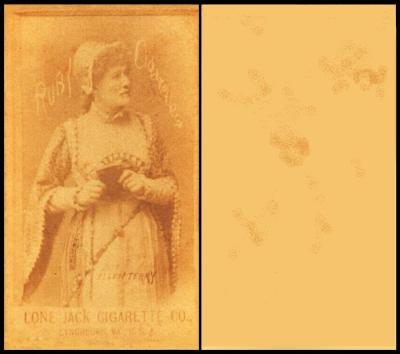
Firstly our thanks to Mr. Lloyd, who sent this card in as a scan. He would also like to know more about it, especially whether it is trimmed in any way.
I am certain that few of us have come across this card before, or heard of the issuer. I am one, it is a mystery to me, but I have found a few things out, and maybe you can add more?
In our original World Tobacco Issues Index, Lone Jack Cigarette Co. are cited as being located in Lynchburg, Virginia, USA. There were several brands, `Lone-Jack`, `Ruby`, `Straight-Cut` and `Special` Cigarettes. The header from that book tells us that the cards were issued about 1885 - 92, and that Set L60-3 ("Language of Flowers") was also available in the U.K.
In that volume, our set is split into two groups, and so was the listing in Jefferson Burdick`s catalogue, however he only valued them at 25 cents a card. The listing in our book reads :
ACTRESSES (A). Sm. 65 x 38. Sepia. Subjects unnamed. Unnd. Ref. USA/367.
1. "Lone Jack Cigarettes" in design. 2 seen
2. "Lone Jack Cigarettes" in border above picture. Possibly same subjects as set G26-1-1 (Genesee). 5 seen.
Now Genesee is the Genesee Tobacco Works of Rochester, New York. I cannot confirm or deny whether the cards are the same, or even similar, but if you can, please do.
There is a slight question about our listing above, because our card is named as being Ellen Terry, on her dress. We do know that some of these cards are said to be "named" simply because someone has written the identity on, and they are not always correct in their naming. This is less of a problem now that most internet auctions show pictures of the cards, but finding out such things only when the card arrived used to bring a lot of disappointment to collectors in the olden days!
Our updated World Tobacco Issues Index has a slightly different listing, namely :
ACTRESSES (A). Sm. 65 x 38. Sepia. Subjects unnamed. Unnd. Ref. USA/367.
1. "Lone Jack Cigarettes" in design. (2 seen)
2. "Lone Jack Cigarettes" in border above picture. (4 known) Ref. USA/367.
Now someone has got in touch with us and said that there is another set we ought to bring into play, that is by Heisel's Gum and it is known as "Actress Gum (E180)". I will hand this straight over to you, whilst I research it.
Friday, 1st March 2024
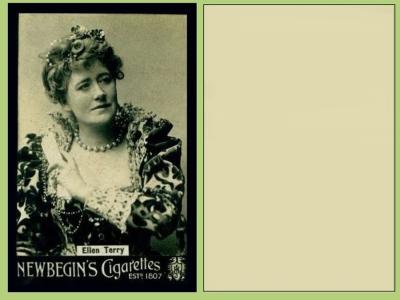
According to the backs of the set of "Well Known Proverbs", Edward Newbegin founded his company in 1807. The cards were issued between 1900 and 1908. And their top selling brand was "Mabel Love Cigarettes", named after the celebrated beauty, who appeared on hundreds, if not thousands of picture postcards.
We know that his full name was Edward Joseph Newbegin, and we think he was born in the early 1790s. We know that he was born in Norwich, and that he inherited the business from his father, but then it is said that retired and allowed a man called Adcock to take it over.
That company then became Adcock & Son, of Exchange Street, Norwich, whose only set of cards was “Ancient Norwich”, which we featured as our Card of the Day for the 27th of January 2025
Returning to our story, in 1863 our man moved to Sunderland in County Durham and he opened another company at the former Eagle Works Tobacco, Cigarette and Snuff Manufacturer and Tavern. This was based at 201 High St. And if you look at the base of our card it has a logo on the right hand side, and that is an eagle, with his initials entwined within it.
Two years later he was back in Norwich, getting married to a local lady, who was in her thirties. He then took her up to Sunderland, and they had five sons.
He died in January 1892, aged sixty-two
This set is described in our World Tobacco Issues Indexes as :
ACTORS AND ACTRESSES etc. (A). Sm. 60 x 39 Black and white photos, inscribed at base "Newbegin`s Cigarettes. Est. 1807". Unnd. 40 known. See H.299 and Ha. 299.
Well I had better depart, I am running out of eyes. A few codes will be added tomorrow, but that is pretty much it. I am going to sit and listen to the motor racing now, with my eyes closed.
Thanks for tuning in - and do come back next week!
